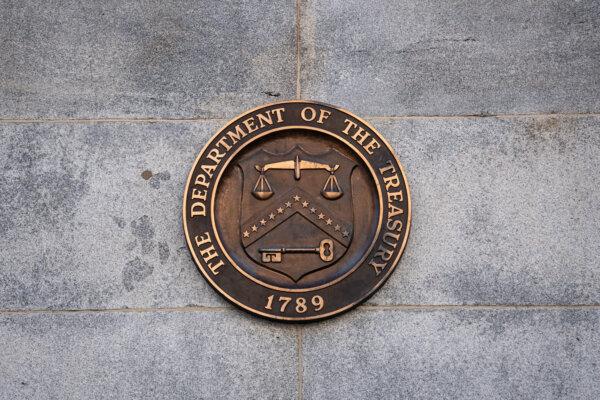Yields have been the primary factor for foreign investors, experts said.
Foreign investment in U.S. debt surged by 7 percent in 2024, while domestic demand for Treasury securities has been lackluster over the past year.
According to new Treasury data, total holdings of Treasury securities reached $8.51 trillion last year, up from $7.94 trillion at the end of 2023.
However, foreign investors curtailed their exposure to Treasury bills, bonds, and notes in December 2024, declining by approximately $120 billion.
Japan and China, the world’s largest holders of U.S. debt, reduced their holdings. Tokyo trimmed its exposure by $28 billion to $1.06 trillion, while Beijing cut its holdings by $9 billion to $759 billion. Both nations lowered their exposure to U.S. debt in 2024.
Many nations, such as the UK, India, and Brazil, also decreased U.S. assets in their portfolios to finish the year. Conversely, Luxembourg, Canada, Belgium, and Mexico added more Treasury debt to their investment portfolios.
Still, Treasury data and auction results show that foreign investment has accelerated over the past year, especially compared with domestic demand for U.S. government bonds.
During the $25 billion 30-year bond auction on Feb. 13, indirect bidders—commonly foreign entities—scooped up nearly two-thirds of the supply. Direct bidders—U.S. institutions such as insurance companies and pension funds—bought 16 percent of the Treasury securities. Primary dealers—financial institutions that acquire the remaining supply—purchased what was left.
Likewise, the $16 billion 20-year bond auction witnessed foreign investors buying 63 percent of the Treasurys. Additionally, the $42 billion 10-year auction on Feb. 12 saw foreign investors scoop up 72 percent of the supply.
All About the Yields
The difference in yields in global bond markets has been a significant reason for the trend. Returns on U.S. Treasury securities have been extremely attractive compared with the offers in other advanced and developing markets.
“When the Fed started raising interest rates in March 2022, foreign private investors started buying a lot more Treasurys because they liked the higher level of yields,” Torsten Slok, chief economist at Apollo Global Management, told The Epoch Times in an emailed note.
The benchmark 10-year yield is above 4.5 percent—and had climbed to as high as 4.8 percent before retracing its steps. By comparison, Canada’s 10-year yield is below 3.18 percent, Germany’s 10-year bond hovers around 2.55 percent, and Japan’s 10-year bond is below 1.5 percent. This has prompted solid foreign interest in U.S.-denominated fixed-income assets.
“Foreign demand has remained strong, bolstered by a robust and appreciating U.S. dollar—a development for which many foreign family offices and institutional investors were inadequately prepared,” Michael Ashley Schulman, chief investment officer at Running Point Capital Advisors, told The Epoch Times.
“With many developed markets offering low yields, U.S. Treasurys stand out for their liquidity, stability, and comparatively attractive rates,” he said.
The greenback has taken a breather so far this year, sliding more than 1 percent. However, over the past 12 months, the U.S. dollar index has surged by about 3 percent, proving to be one of the top-performing currencies in the global economy.
The index is a gauge of the buck against a weighted basket of currencies such as the euro and the UK pound.
U.S. Treasury yields have rocketed since autumn, when the Federal Reserve kicked off its easing cycle with a supersized half-point interest rate cut and Donald Trump won the presidential election. Market analysts have attributed the rise to various factors, from fiscal policy concerns to optimism about the broader economy.
But while foreigners are ostensibly bullish on U.S. Treasury securities, the same cannot be said for domestic investors.
In the United States, traders have become weary since the Treasury Department began flooding capital markets with new debt to manage the ballooning budget deficit and rising interest payments.

In 2024, the Treasury issued approximately $2 trillion in bonds, according to the department’s refunding estimates.
Schulman said this has placed a renewed focus on the widening supply-demand dynamics.
“The domestic bond market has faced a surplus of issuance due to escalating government deficits and corporate borrowing demands, creating tension between supply and investor demand,” Schulman stated.
In December, the Congressional Budget Office (CBO), a nonpartisan budget watchdog, expressed concern in its analysis of extending the Trump-era tax cuts, stating that prolonged debt issuance could exacerbate the crowding-out effect in the coming years. The CBO stated that deficits can crowd out private domestic in the long run, weighing on productive capital and national savings.
The Path of US Yields
Forecasts vary, but many market observers share the same view: Treasury yields are staying higher for longer.
Padhraic Garvey, regional head of research at ING, said the 10-year yield could top 5 percent by year’s end.
“Even if the deficit pressure is reduced (and we won’t assume this just yet), the rates market will still have to contend with the impact of a tax-cutting agenda to be legislated in 2025, taking effect from 2026,” Garvey said in a December note.
“On top of that is the threatened implementation of tariffs, whose effect on prices would be a thing through the second half of 2025 and 2026. We view 2026 as being closer to a 3% inflation environment than a 2% one based on this.”
Investors should not expect the 10-year yield to fall off a cliff anytime soon, either.
According to the Federal Reserve Bank of Philadelphia’s first-quarter survey of professional forecasters, the benchmark yield is projected to average 4 percent.
With the U.S. central bank expected to pause its rate-cutting cycle for several months amid its inflation fight—the futures market anticipates the next quarter-point rate cut in September—yields could remain elevated for an extended period.
At the same time, factoring in geopolitical tensions, trade strife, and above-trend inflation, volatility could dominate the conversation for the foreseeable future, according to Tom Essaye, president and founder of Sevens Report Research.
“For this market to continue to weather those issues, growth is going to have to stay Goldilocks, and so far, that’s exactly what’s happened in 2025,” Essaye told The Epoch Times in an emailed note.

